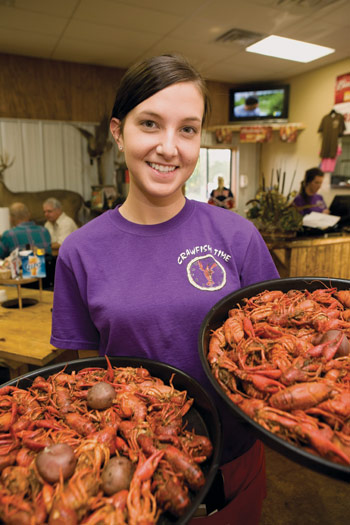
Photos by Philip Gould
Crawfish Time employee Amy Barnes gets ready to serve up two orders of the “best boiled crawfish” in Acadia Parish.
It is a cool March Friday evening in Lafayette, La. At Brant and Jason Lamm’s two restaurants, the drive-through line slowly snakes out to the street, and patrons gladly wait an hour or longer for a table. For these two brothers, all this means one thing: It’s crawfish time.
Since forming their business just out of college, the Lamm brothers have evolved into two of the most successful and respected crawfish entrepreneurs in Acadia Parish — no small feat in a region replete with crawfish operations. Through hard work, an eye on quality and a lot of smart decisions, these Louisiana Land Bank customers have built a career that neither one ever anticipated.
An Unexpected Career Turn
The elder brother, Brant, majored in business administration at the University of Louisiana-Lafayette, fully expecting to join his dad in the medical administration business. But when a friend suggested that Brant team up with him to open a small drive-through location selling boiled crawfish, Brant jumped on the idea. "I had worked in my uncle’s crawfish operation during college, and had learned a lot about the business," Brant says. A few years later, when Jason graduated college and the original partner moved on, the brothers joined forces to grow and market their catch.
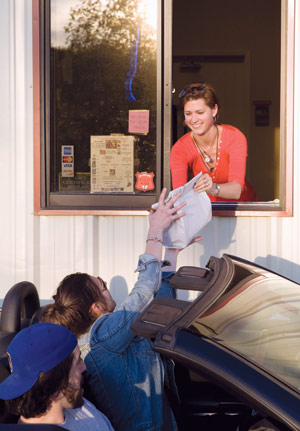
Brant Lamm’s wife, Khristy, works the take-out window at one of the family-owned restaurants.
They kept the operation small at first, renting 121 acres of their uncle’s rice land, crawfishing behind his rice crop and selling live crawfish. Over time they added more rental acreage, and in 2003, they approached Louisiana Land Bank about a loan to buy their uncle’s property.
"They came in with their dad, who also is a Land Bank member and who was going to co-sign," recalls Barry Fontenot, vice president/branch manager in Louisiana Land Bank’s Crowley office. "I suggested they try to buy it on their own. They did, and it has worked out great.
"They work very hard, they work well together, and they’ve been very successful," Fontenot says.
Smart, Slow Growth
Making those kinds of deliberate and calculated business decisions has been one key to their success. Over time, Brant says, they steadily added ponds, and today they farm 1,200 total acres — 400 owned and the remainder operated on either a cash-rent or a percentage basis. To handle their average daily catch of 250 sacks of crawfish — some 8,750 pounds — they paid cash for nine crawfish boats.
In 1997, the brothers launched Crawfish Time, a drive-through and take-out location in Lafayette, just down the road from their Crowley ponds. They opened a sit-down restaurant in 2006 and today have 50 employees between the farming and restaurant businesses.
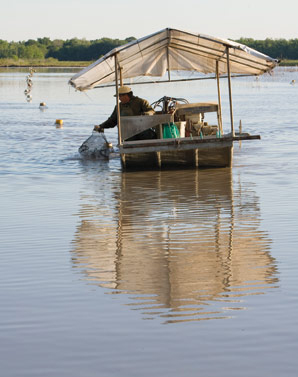
Just hours after being caught (above), the crawfish are cleaned and sorted by size (below).
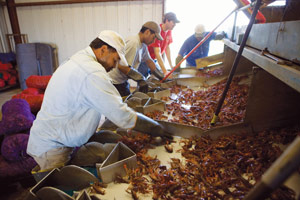
Quality Through Personal Attention
Harvest is a hectic time that demands the help of nine field hands, who each maneuver boats across 200 acres daily, checking some 2,000 traps a day. "Foot steering frees up the driver’s hands to empty the trap into sacks, rebait it and keep moving to the next one without stopping," says Brant. "When the boat gets full, the driver sets them out on the levee on burlap-covered pallets to protect them from the heat."
By midday, truck beds full of the bagged catch begin arriving at the Lamms’ processing facility, where another smart investment has paid big dividends. A $30,000 automated processor enables a team of four to six workers to clean, cull and sort the crawfish by size — a system few area crawfish farmers employ. The crawfish are dumped first into a washing system that eliminates most of the mud and grass. From there, they travel up a conveyor belt, which sorts the catch by size into small, medium and large trays. Workers hand-cull any dead crawfish from the trays, then bag the catch into color-coded burlap sacks by size.
The Lamms sell the smallest crawfish to peeling plants for use in processed foods. "The medium, we sell live by the sack, or sell to Shreveport buyers," says Brant. The large catch, however, rarely gets beyond their two Crawfish Time restaurants.
"Best Boiled Crawfish" Title
"For the restaurants, we serve the biggest crawfish possible," says Brant. The larger size and the cleanliness of their catch are two reasons, he believes, why the Times of Acadiana awarded them the "Best Boiled Crawfish" title in 2008.
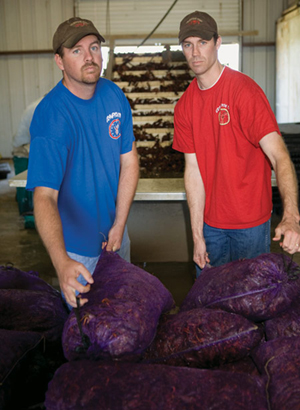
Jason and Brant Lamm
The process is repeated seven days a week, from December to June. The successful operation doesn’t come without hard work. Jason delivers crawfish to the drive-through each day as well as working there. Brant takes the later shift at the sit-down location, which also has a take-out window. "From December to the end of June, we don’t think about anything else. In November, I deer hunt," Brant says.
“We focus on the best-tasting and best-quality crawfish.” — Brant Lamm
Competition has skyrocketed over the years. "People see what we are doing and think they can do this," he says, noting at least five acquaintances who have opened boiling places after watching the Lamms’ success. "They haven’t affected us though. They aren’t grading their crawfish. They aren’t on site watching over every aspect.
"We focus on the best-tasting and best-quality crawfish. We’ve been doing this 14 years now, and our customers know what they are getting with us," Brant says.
For more information about the Crawfish Time restaurants, phone (337) 236-6129.
– Sue Durio
Know Before You Buy
Crawfish Cooking Like the Pros
Tips for your next backyard boil
- Take care. Keep your live crawfish cool and damp until you’re ready to begin cooking.
- Don’t smother. Many people mistakenly smother live crawfish in salt water. Plain water is all you need to clean them for no more than 30 minutes.
- Stay fresh. Whenever possible, pick up your crawfish from the supplier no more than an hour before cooking them.
- Don’t overcook. When your water is at a full boil, add the crawfish. Once the water returns to a boil, or the crawfish are floating, scoop them out into a clean ice chest or tub.
- Season last. Contrary to generally accepted practice, the Lamms do not season the water. Instead, do what they do: Wearing elbow-length plastic gloves, thoroughly mix two 16-ounce cups of seasoning per one 40-pound bag of cooked crawfish. Let the crawfish sit in the ice chest for about 10 minutes to continue absorbing the flavor. C’est si bon! Board
Fast Facts About a Hot Crop
- Louisiana is home to more than 30 species of crawfish.
- Crawfish farming is the largest aquaculture industry in the U.S.
- Louisiana leads the nation in crawfish production, producing more than 90 percent of the domestic crop.
- More than 1,600 farmers produce crawfish in some 111,000 acres of ponds.
- The economic impact on the Louisiana economy exceeds $120 million annually.
Source: Louisiana Crawfish Research and Promotion Board